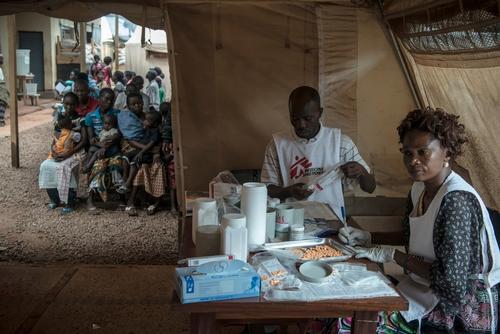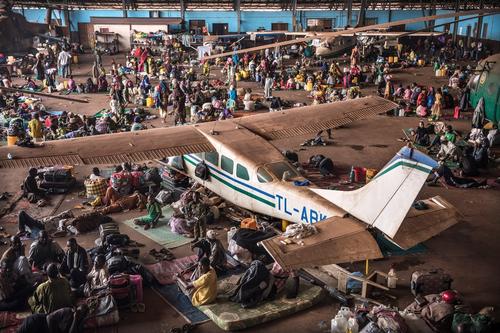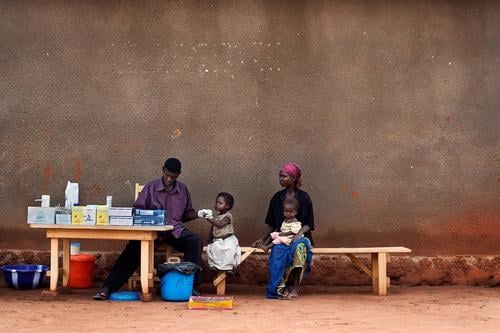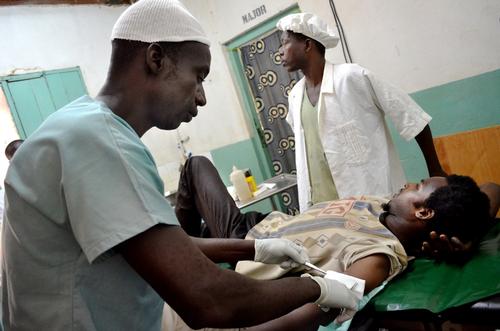The brutal crisis in the Central African Republic has gone largely unnoticed internationally except, perhaps, for this one iconic image: a sea of displaced people huddled in the hulls of abandoned, rusty planes. This was Mpoko international airport, in the capital Bangui. At its peak, 100,000 people lived in this camp. Those who couldn't shelter in the ruins of old aircraft piled into empty warehouses, or built a roof over their heads with whatever scraps they could gather.
Three years on, however, the international flights that land in Bangui do so next to empty land. Bulldozers came and went, and most of the 20,000 people who were still living in Mpoko have now returned to where they came from.
But this closure still matters. Here's why :
It's not over
The closure of Mpoko is good news. It is a sign that the Central African Republic is stabilising; a country where even the oldest citizens cannot remember more than very brief periods of relative stability. But this closure remains largely symbolic. The displaced people have little to return to: precarious safety, poor to non-existent infrastructure, destroyed houses still riddled with bullets, and 150 euros in cash for families of six to re-start their lives from scratch. Countrywide, one in four people are still displaced, either inside or outside national borders.
The camp's closure had officially been a priority for nearly three years. For example in September 2015, after a year of relative calm in Bangui, the camp's population had dwindled to 6,000 people and MSF was preparing to close its hospital and clinics. But just a few days before the scheduled reduction of MSF activities, the conflict flared up. Yet again, thousands ran to the relative safety of the airport, and the hospital was flooded with people: the number of consultations rose from 250 a day to 400.
So whilst there is cause for cautious optimism, what the history of Mpoko camp tells us is that tomorrow is uncertain in the Central African Republic.

Iconic Mpoko Camp Closes
It was not (all) doom and gloom
The Central African conflict that caused the camp to spring to life in the first place reached horrifying levels of violence, with atrocities committed by both sides. MSF's teams, who started providing medical support in Mpoko just one day after the first families arrived, witnessed horrendous acts such as dismemberments.
The living conditions in the camp were difficult for the thousands of traumatised people who sought refuge there. But like anywhere else in the world, life and death happened side by side. For three years, families did their utmost to maintain a minimum of dignity despite everything; 5,807 babies were born in MSF's field hospital in Mpoko.
At the time of the camp’s closure services were being provided to others apart from displaced people. Two thirds of the patients in MSF's hospital in Mpoko were from outside the camp; some were walking for hours to reach the hospital because there were no other free and reliable medical services accessible to them. Now that the hospital closed they will need to rely on the weak public services in Bangui. The Central African Republic has not solved its deep-rooted problems.

It was an international matter (kind of)
The conflict in the Central African Republic started in 2012. On 4 December 2013, the UN Security Council and, a few hours later, France vowed to take action to stop what were already intolerable levels of violence. One day later, Bangui, where some fighting was already taking place, collapsed into all-out war and the first people fled to Mpoko, seeking protection from the UN and French troops based at the airport. International troops have been central to the recent history of the Central African Republic, for better and for worse: the still unresolved accusations of sexual abuse by French and UN troops in the country remain an ineffable stain on their reputation.
Aside from the mobilisation of military resources, however, the Central African Republic remains at the bottom of international priorities. Despite the huge, glaring needs of a population in distress, there is not much appetite to provide basic services in such a dangerous and tense environment. For three years, except for MSF's permanent medical presence there were few services in the camp and Mpoko was mostly a squalid place to live. Mpoko and indeed the Central African Republic never saw a mobilisation of international aid at levels similar to other displaced people or refugee camps in the world.
It was, in a limited way, a trigger to action
Squalid, yes; forgotten, yes; but still Mpoko camp was the entry point for the coverage of the terrible humanitarian crisis in the Central African Republic. The displaced people lived on the tarmac of the landlocked country's international airport. It was, quite literally, the first thing you saw when you arrived. Travelling across the Central African Republic is difficult at the best of times as there are few decent roads, and these were highly dangerous during the crisis. So, for visiting reporters and their readers around the world, Mpoko became the image of this under-reported crisis that could otherwise have been completely ignored.
Mpoko has now closed. What became a symbol of the huge needs of the Central African people has disappeared, but the country's problems persist. Without this iconic image how can the goodwill of donors, public and private, continue to be mobilsed to help the half of the population that still rely on humanitarian aid to survive?

You did something good (if you're an MSF donor)
Mpoko was a special project for MSF. All teams still remember the extraordinary challenge of building a full 60-bed field hospital in a matter of a few days, on a piece land where there was nothing, and at the peak of an extraordinarily brutal conflict. Our teams worked there every day, for 1,000 days – international professionals alongside courageous national staff. All our Central African colleagues suffered through the worst of the conflict with their loved ones, some of them even living in the displaced persons camp as they had lost everything. Together, our staff provided 440,000 medical consultations, 46,000 interventions in the emergency room, and hospitalised 11,000 people in a temporary structure made of wooden planks and tarpaulin.
All this was possible thanks to the private donors from all over the world who support MSF.
On behalf of all those patients:
Thank you
The crisis in the Central African Republic is not yet over. MSF remains one of the main health actors in the country, with 17 medical projects across the country, including a surgical programme and a maternity project in Bangui.






